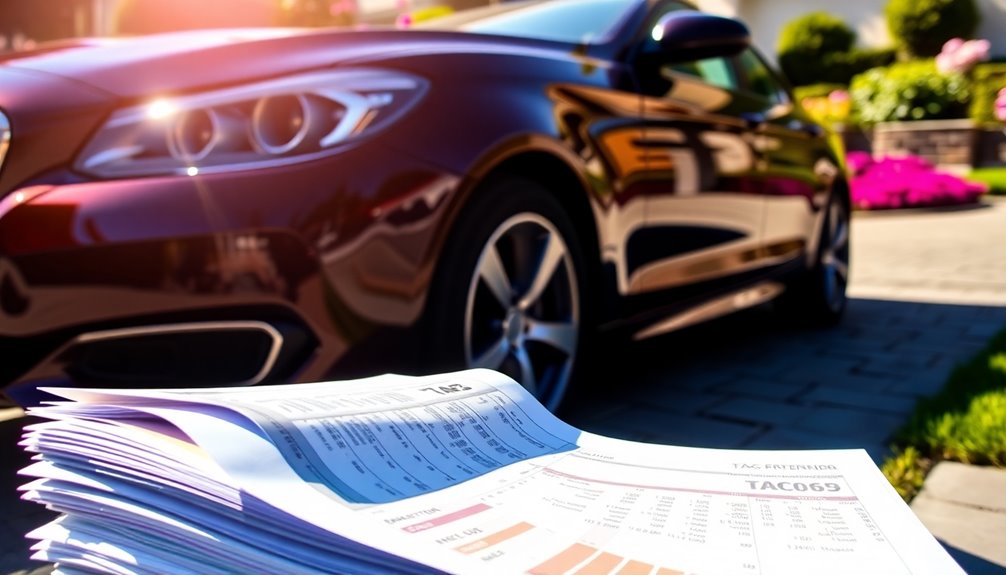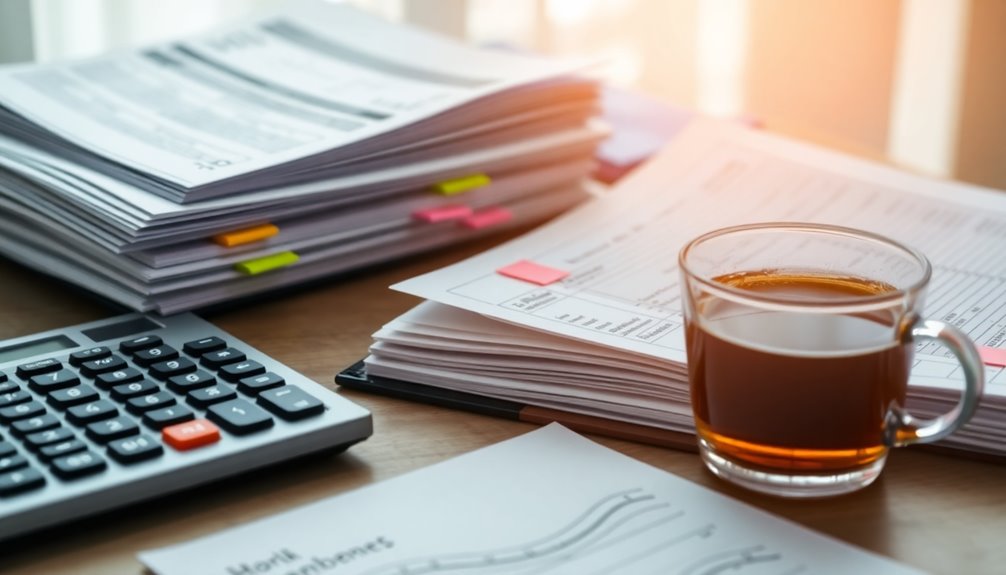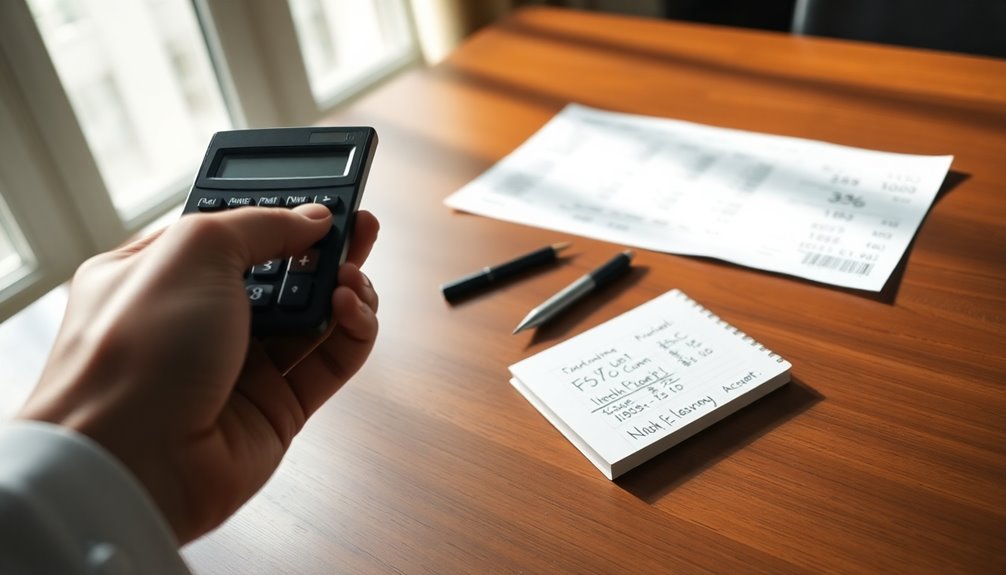As a DoorDash driver, you're considered an independent contractor, meaning you'll report all your earnings on Form 1040 and likely receive a Form 1099-NEC for earnings over $600. You're responsible for paying your taxes without any withholding. Track your income, expenses, and mileage meticulously, as these will help maximize your deductions. Be sure to report all income, even smaller amounts, and remember to pay your estimated quarterly taxes if needed. Filing on time and keeping organized records will help you avoid penalties. Keep going to discover tips and best practices to simplify your tax process.
Key Takeaways
- As a DoorDash driver, report all earnings using Form 1040 and include income from all sources, even if under $600.
- Keep detailed records of business expenses like vehicle costs, parking fees, and phone bills to maximize deductions.
- Use Schedule C to outline your DoorDash income and expenses, ensuring accurate representation of your business activities.
- Pay estimated quarterly taxes if your tax liability exceeds $1,000, including federal and state income taxes and self-employment tax.
- Consult a tax professional for complex situations and stay informed on tax regulations affecting independent contractors.
Understanding Your Tax Classification
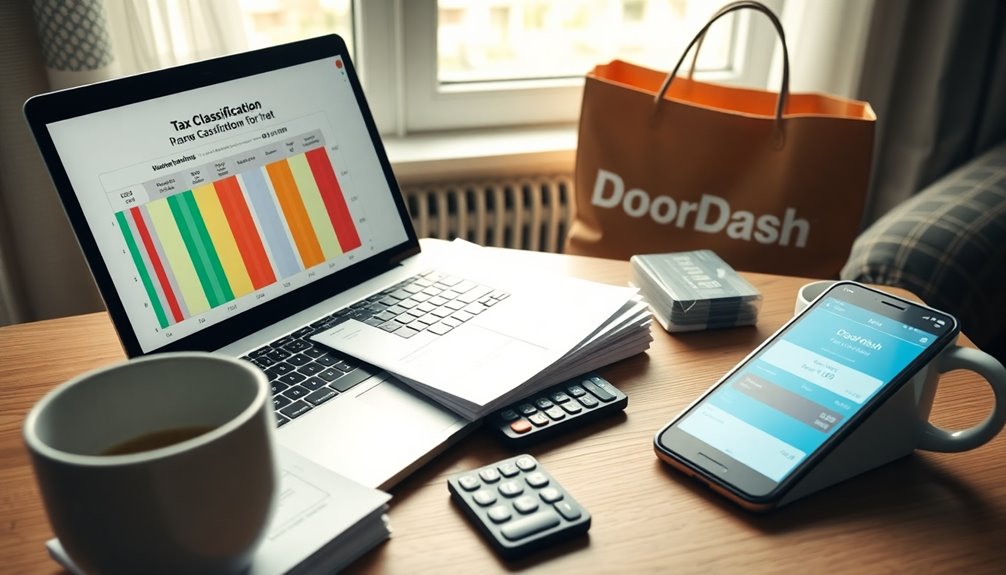
When you start working as a DoorDash driver, it's crucial to understand that you're classified as an independent contractor rather than an employee. This classification means DoorDash won't withhold taxes from your earnings; you're responsible for your own tax payments.
Essentially, you're viewed as a small business owner by the IRS, which comes with specific tax obligations.
You'll need to pay federal and state income taxes, plus self-employment taxes, which include Social Security and Medicare taxes at a rate of 15.3% on your taxable income. Federal income tax rates vary from 10% to 37%, and state rates can range from 0% to 13.3%. Additionally, as an independent contractor, you are required to pay estimated quarterly taxes if your expected tax liability is $1,000 or more, you'll have to make quarterly estimated tax payments to avoid penalties.
It's essential to set aside money for taxes since DoorDash doesn't withhold any for you. Keeping accurate records of your income and expenses will help you report correctly on your tax returns.
You can also deduct business-related expenses, like vehicle mileage and repairs, which can minimize your tax liability. Proper planning is key to navigating this independent contractor status successfully.
Tax Forms for DoorDash Drivers
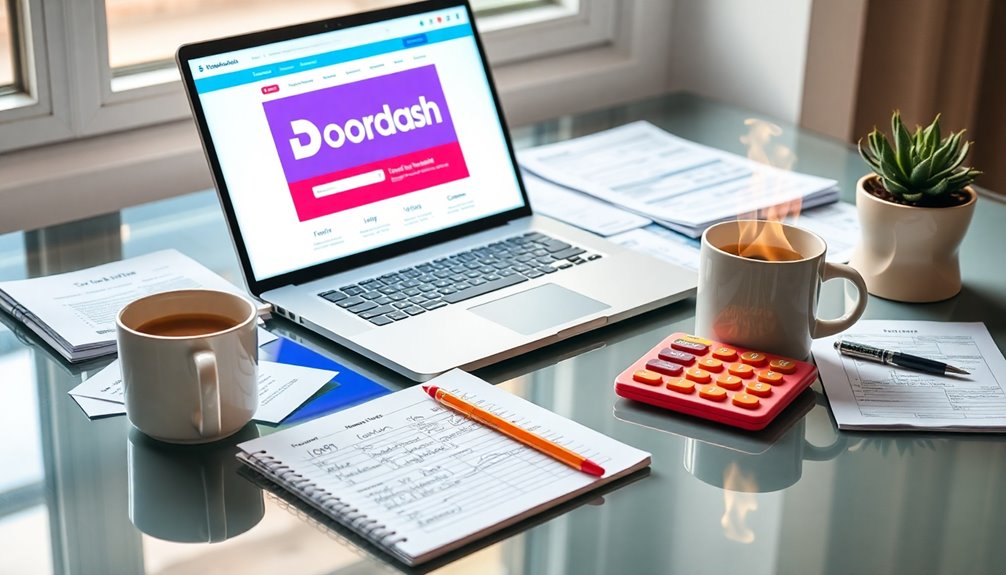
Tax forms play a vital role in how DoorDash drivers report their earnings and expenses. As a driver, you'll primarily need Form 1040 to report your overall income. If you earn over $600 in a year, DoorDash will send you a Form 1099-NEC, which details your nonemployee compensation.
You'll also use Schedule C to outline your income and expenses related to your DoorDash business. Keep an eye on state and local tax forms as well, since additional paperwork might be necessary depending on where you live. Occasionally, you might receive a Form 1099-MISC for specific types of payments, though this is less common.
To obtain your tax forms, you can choose between electronic delivery via a Stripe Express account or request paper copies. Make sure your Social Security Number or EIN is linked correctly to your DoorDash account to avoid issues. Knowing which 1099 form applies to your earnings is essential for accurate reporting.
Monitor your email for notifications from Stripe to stay updated on your tax forms. Accurate reporting of your earnings, including tips, is crucial to prevent tax complications, so maintain thorough records throughout the year.
Tax Responsibilities and Payments

As independent contractors, DoorDash drivers carry the responsibility of managing their own taxes, which can feel overwhelming at times. Unlike employees, DoorDash doesn't withhold taxes from your earnings, so it's crucial to stay on top of your tax obligations. You must report your income to the IRS and are classified as a sole proprietor unless you've set up a business entity. You'll owe several types of taxes, including federal income tax, state income tax, and self-employment tax. The federal income tax rate ranges from 10% to 37%, while state income tax can be as high as 13.3%, depending on where you live. Additionally, it's important to understand that gross earnings reported on your 1099-NEC are considered nonemployee compensation. Don't forget about the self-employment tax, which is 15.3% of your taxable income. To avoid penalties, you may need to make quarterly estimated tax payments. Since DoorDash doesn't withhold taxes, it's smart to set aside a portion of your earnings for tax payments. Using a 1099 tax calculator can help you estimate the amounts you'll owe. Remember to keep accurate records of your income and expenses, and ensure your Social Security Number or Employer Identification Number is linked correctly to your DoorDash account.
Deducting Business Expenses

Deducting business expenses is essential for maximizing your earnings as a DoorDash driver. Start by tracking your vehicle and transportation expenses. You can choose between the standard mileage rate of $0.655 per mile in 2023 or the actual expense method, which includes costs like gas, oil, repairs, and depreciation. Remember that using the standard mileage deduction may limit the vehicle-related deductions you can take.
Don't forget to deduct parking fees and tolls incurred during deliveries.
Next, consider your cell phone and data expenses. Since these are necessary for using the DoorDash app, you can deduct a portion of your cell phone bill related to business use. Keep records to distinguish between personal and business usage.
Look into equipment, tools, and supplies, too. Costs for hot bags, insulated packaging, and delivery-related clothing are deductible. If you use a bicycle, expenses like helmets and locks can also be deducted.
Lastly, account for fees and services like business licenses, navigation app subscriptions, and outsourced accounting fees. If you pay for health insurance, you may be eligible for a deduction as well.
Keeping thorough records and documentation will help support your deductions come tax time.
Filing Your Tax Return

Filing your tax return can feel daunting, but getting organized simplifies the process significantly. First, you'll need to receive your 1099-NEC form from DoorDash, which they send by January 31 if you've earned over $600 during the year. This form includes your total non-employee compensation, base pay, tips, pay boosts, and milestones. Ensure your tax information—like your name, address, and Social Security number or EIN—is accurate to receive your form without issues.
Next, gather all necessary tax documentation. Alongside the 1099-NEC, collect other income tax forms, such as W-2s if you have additional employment, and any 1099s from other gig platforms. Income still needs reporting even if you do not receive a 1099 form for earnings below $600, so make sure to include all your income sources.
Organize these documents carefully to make filing easier.
When you're ready to file, do it by mid-April, typically the 15th. You can use IRS Free File, paid software, or hire a tax professional.
Complete Form 1040 and attach your 1099-NEC, reporting all your income accurately. If you owe taxes, make sure to pay them by the deadline to avoid penalties.
Staying organized will help you navigate your tax return smoothly.
Avoiding Penalties and Audits
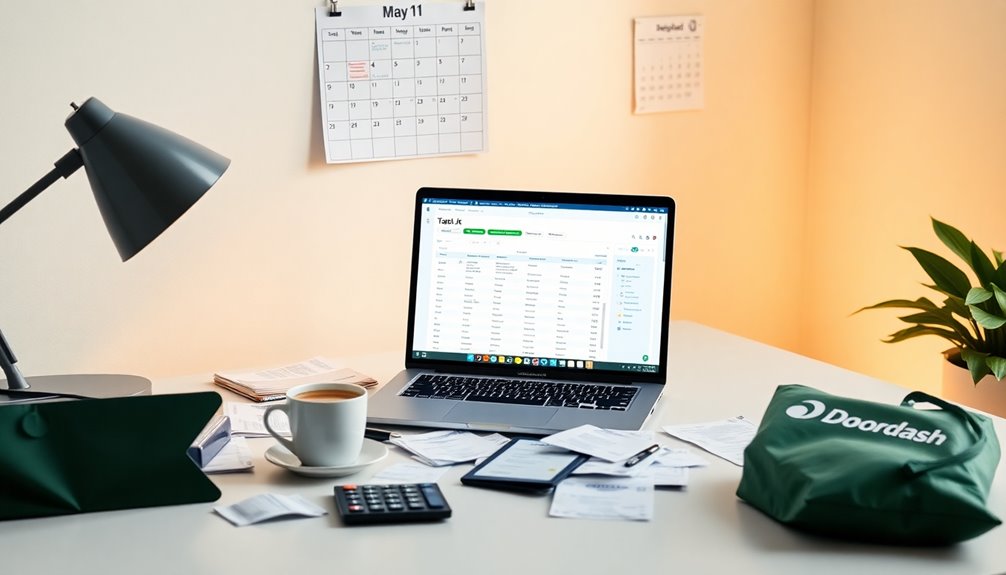
Navigating your tax obligations as a DoorDash driver can be tricky, but staying informed can help you avoid penalties and audits.
First, understand that if you earn more than $600, you'll receive a 1099-NEC form, while a 1099-K applies if you make over $20,000 with 200 or more transactions. Remember, DoorDash doesn't withhold taxes, so you must plan to pay federal, state, and self-employment taxes on your earnings. Additionally, self-employed individuals face increased scrutiny from the IRS, making it crucial to ensure your records are in order.
To prevent underpayment penalties, make quarterly tax payments to the IRS. It's essential to keep accurate records of all income and expenses, separating business from personal spending. This will help when claiming deductions and reduce your audit risk.
Be aware that discrepancies between your reported income and third-party information can trigger audits. To avoid this, ensure all your figures match tax forms and keep detailed documentation of your deliveries.
If you have questions or face complexities, consider consulting a tax professional for guidance. Staying organized and informed won't only help you navigate taxes but also minimize the chances of penalties and audits.
Managing DoorDash Earnings

Managing your DoorDash earnings effectively is crucial for maximizing your income and minimizing tax liabilities. As a driver, you'll receive a 1099-NEC form if you earn over $600 in a year. This form lists all your gross earnings, including base pay, tips, pay boosts, and milestones, which you need to report on your tax return.
Remember, you're responsible for federal and state income taxes, as well as self-employment taxes covering Social Security and Medicare, which totals 15.3% of your taxable income. Independent contractors are required to make estimated tax payments if their expected self-employment taxes exceed $1,000.
To reduce your taxable income, you can deduct various business expenses like mileage, parking, tolls, and cell phone usage. Track your mileage at 57.5 cents per mile and keep records of other expenses like courier bags and repairs.
It's essential to maintain accurate records to maximize these deductions. Ensure you meet tax deadlines, especially if your expected self-employment taxes exceed $1,000, as you'll need to pay estimated quarterly taxes.
Staying organized and timely will help you avoid penalties while ensuring your earnings are managed effectively.
Utilizing Tax Tools

Tax tools can be your best ally in streamlining the process of tracking and reporting your DoorDash earnings. For mileage tracking, consider using apps that help you log work-related miles, ensuring you exclude commuting miles. You can deduct $0.56 per mile, covering gas, maintenance, insurance, and depreciation. Keeping a mileage log is crucial to verify the percentage of your vehicle's use dedicated to business.
Alternatively, you might choose to deduct actual vehicle expenses, including gas and car payments. Be sure to track the portion of vehicle use dedicated to DoorDash to maximize your deductions.
Don't forget other business expenses! You can write off a portion of your cell phone usage, as well as expenses for tools like hot bags and insulated courier bags. Parking fees and tolls incurred during deliveries are also deductible, along with vehicle inspections and repairs tied to your DoorDash work.
Utilizing the right tax forms is essential, too. Report your earnings on the IRS Form 1099-NEC and file your income tax return using Form 1040. For self-employment income and deductions, use Schedule C.
Best Practices for Record Keeping

Keeping accurate records is vital for any DoorDash driver looking to maximize their deductions and simplify their tax filing process. Start by tracking your mileage. Use apps to log work-related miles, ensuring you distinguish between commuting and delivery-related mileage. Remember to include miles driven between deliveries and to delivery zones. Keep a detailed mileage log that includes dates, distances, and purposes.
Next, document vehicle-related costs. Save receipts for gas, oil changes, and maintenance. Don't forget to record tolls and parking fees incurred during deliveries, as well as car repairs and inspections. Include costs for insurance and depreciation, correlating these with your mileage log. Additionally, understanding that DoorDash drivers receive a 1099 form can help you ensure you're properly documenting all income and expenses.
You should also record other business expenses. Keep track of phone bills if you use your phone for DoorDash, and calculate the business-use portion. Document costs for insulated bags and any health insurance premiums related to your work.
Finally, organize and report your expenses properly. Use Form 1099-NEC for reporting DoorDash income, and fill out Schedule C (Form 1040) for deductions. Maintaining detailed records throughout the year ensures you can claim your business deductions accurately come tax time.
Frequently Asked Questions
Can I Write off My Doordash Driver Training Expenses?
Yes, you can write off your DoorDash driver training expenses if they're directly related to your business.
Keep track of any costs incurred, like course fees or materials, as these can be deducted on your taxes.
Make sure to maintain accurate records, including receipts and invoices, to support your claims.
This way, you can reduce your taxable income and potentially lower your tax liability.
Just ensure these expenses meet IRS guidelines for deductions.
What if I Didn't Receive My 1099-NEC Form?
If you didn't receive your 1099-NEC form, don't worry; you still need to report your income.
First, check your payment records to confirm you earned $600 or more. If you did, contact DoorDash to resolve the missing form issue. Make sure your account details are accurate.
Regardless of the form, calculate your earnings from personal records and include all income types, as you're legally required to report everything.
How Does Doordash Income Affect My Eligibility for Tax Credits?
DoorDash income can significantly impact your eligibility for tax credits.
It's included in your modified adjusted gross income (MAGI), which determines your qualifications for credits like the Earned Income Tax Credit and Child Tax Credit.
If your income exceeds certain thresholds, you might lose out on these benefits.
However, accurately reporting business expenses can help lower your MAGI, potentially increasing your credit amounts and maximizing your tax benefits.
Can I File Taxes Jointly if My Partner Is Also a Driver?
Yes, you can file taxes jointly if your partner's also a driver.
You and your partner will report your individual incomes and expenses separately, but you can share expenses like car maintenance if you use the same vehicle.
Just remember, each of you needs to fill out a separate Schedule C form for your business activities.
Keeping detailed records will help ensure you maximize your deductions and simplify the filing process.
Are There Specific Deductions for Food Delivery Drivers Versus Other Self-Employed?
Yes, there are specific deductions for food delivery drivers that differ from other self-employed individuals.
You can deduct mileage and vehicle expenses, including parking and tolls. Business supplies like insulated bags and your cell phone usage are also deductible.
Additionally, you can claim half of your self-employment tax and any startup costs. Keeping detailed records of your expenses will help you maximize these deductions when you file your taxes.
Conclusion
Navigating taxes as a DoorDash driver might seem daunting, but with the right knowledge and preparation, you can make the process smoother. By understanding your tax classification, keeping track of your earnings, and deducting eligible expenses, you'll set yourself up for success come tax season. Don't forget to utilize tax tools and maintain good records to avoid penalties. Stay organized, and you'll not only handle taxes confidently but also maximize your earnings on the road.

